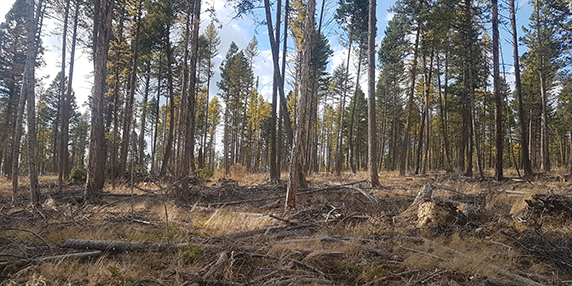Fire Weather Index System
The Fire Weather Index System has six standard components that together provide a numeric rating to indicate the potential for a wildland fire to occur.

The first three components are fuel moisture codes, which indicate the moisture content of the forest floor and other dead organic matter. Their numeric values rise as the moisture content of these materials decreases. There is one fuel moisture code for each of three layers of fuel:
- Litter and other fine fuels (Fine Fuel Moisture Code)
- Loosely compacted organic layers of moderate depth (Duff Moisture Code)
- Deep, compact organic layers (Drought Code).
The remaining three components are fire behaviour indices, which represent
- The rate of fire spread (Initial Spread Index)
- The fuel available for combustion (Buildup Index)
- The frontal fire intensity (Fire Weather Index)
These three values rise as the fire danger increases.
Fine Fuel Moisture Code
The Fine Fuel Moisture Code (FFMC) is a numeric rating of the moisture content of litter and other cured fine fuels. This code is an indicator of the relative ease of ignition and the flammability of fine fuel.
Duff Moisture Code
The Duff Moisture Code (DMC) is a numeric rating of the average moisture content of loosely compacted organic layers of moderate depth. This code gives an indication of fuel consumption in duff layers (2-4 inches) deep and medium-sized woody material.
Drought Code
The Drought Code (DC) is a numeric rating of the average moisture content of deep, compact organic layers. This code is a useful indicator of the effects of seasonal drought on forest fuels and the amount of smouldering that may occur in deep duff layers and within large logs.
Initial Spread Index
The Initial Spread Index (ISI) is a numeric rating of the expected rate of fire spread. It is based on the wind speed and the FFMC. Like the rest of the FWI system components, the ISI does not take fuel types into account. Actual spread rates vary between fuel types.
Buildup Index
The Buildup Index (BUI) is a numeric rating of the total amount of fuel available for combustion on the landscape. It is based on the Duff Moisture Code and the Drought Code, thus taking into account the moisture content of medium-sized to large-sized woody material as well as the effects of seasonal drought on forest fuels. The BUI is used by the BC Wildfire Service to decide when to implement a campfire (Category 1) ban.
Multiple factors are taken into consideration when assessing wildfire hazards and deciding whether to implement an open fire prohibition, including:
- current and forecasted weather conditions;
- the availability of firefighting resources; and
- the Buildup Index (BUI).
Campfire (Category 1) prohibitions are now implemented by the BC Wildfire Service based on a region’s BUI values. Previously, campfire bans were date-driven or based on fire danger ratings, depending on the fire centre.
A campfire (Category 1) ban will be enacted when over 50% of the weather stations within a defined geographic area surpass the BUI threshold established for that area.
BUI thresholds vary throughout the province. The threshold for a given area is based in part on the area’s assigned fuel type, which indicates how volatile those fuels are, how intensely and deeply they will burn, and how difficult it might be to suppress a fire in that fuel type.
Fire Weather Index
The Fire Weather Index (FWI) is a numeric rating of fire intensity. It is based on the ISI and the BUI. It is used as a general index of fire danger throughout the forested areas of Canada.
